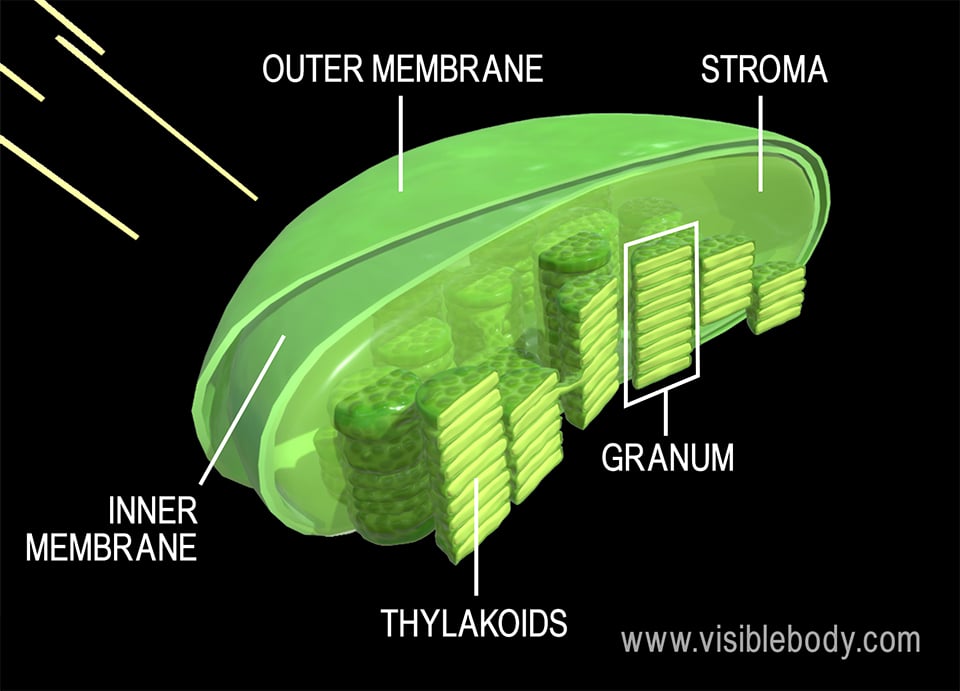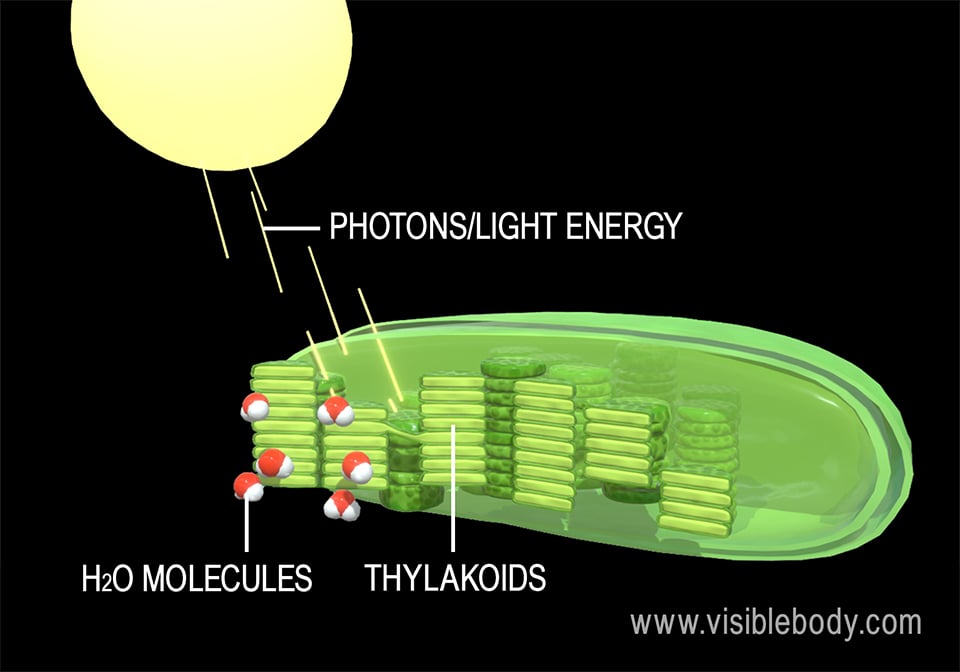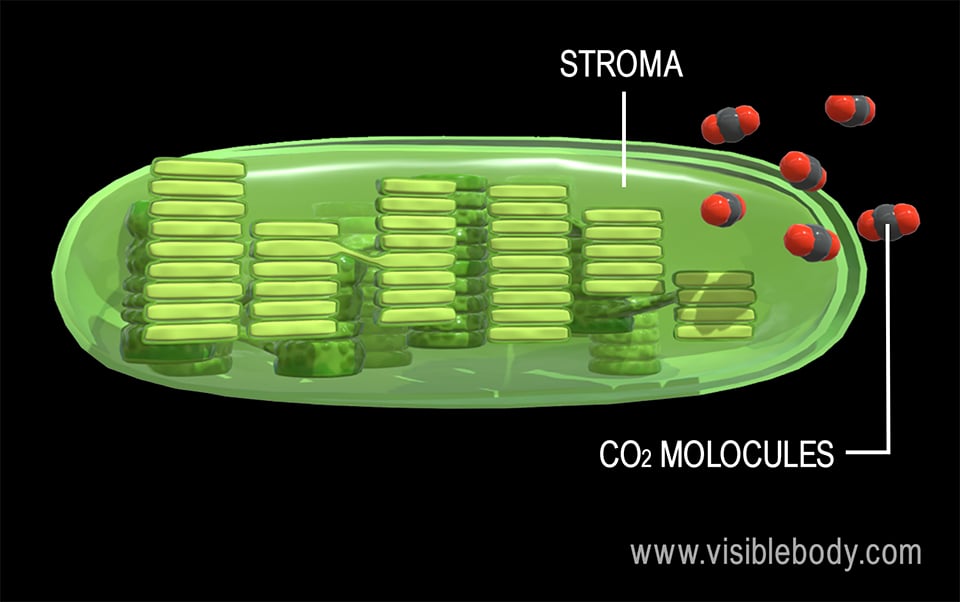Which Set Of Reactions Uses H2o And Produces O2
Zooming into Chloroplasts: Light-Dependent and Light-Contained Reactions of Photosynthesis
Inside plant cells, chloroplasts are specialized organelles that serve every bit the sites of photosynthesis. The reactions that make up the procedure of photosynthesis can be divided into light-dependent reactions, which take place in the thylakoids, and calorie-free-independent reactions (likewise known as dark reactions or the Calvin cycle), which take place in the stroma.
1. Chloroplasts have a complex internal construction, and different reactions take place in different parts of the chloroplast.
Understanding what the inside of a chloroplast looks like is key to visualizing where the different reactions of photosynthesis occur.

Surrounding the chloroplast is a double membrane, consisting of an outer membrane and an inner membrane. This is like in structure to the double membrane of mitochondria.
Interior to the chloroplast's inner membrane and surrounding the thylakoids is a fluid called the stroma. The light-independent reactions of photosynthesis have identify inside the stroma. It contains enzymes that piece of work with ATP and NADPH to "fix" carbon from carbon dioxide into molecules that can be used to build glucose. The chloroplast's own genetic material (separate from that of the prison cell) is also stored in the stroma.
The interior of the chloroplast contains another membrane—the thylakoid membrane—which is folded to form numerous connected stacks of discs. Each disc is a thylakoid and each stack is a granum (pl. grana).
The light-dependent reactions of photosynthesis accept place inside the thylakoids. These reactions occur when the pigment chlorophyll, located within the thylakoid membranes, captures free energy from the sun (photons) to initiate the breakdown of water molecules.
ii. The lite-dependent reactions convert light energy into chemical energy.

The goal of the light-dependent reactions of photosynthesis is to collect energy from the sun and break down water molecules to produce ATP and NADPH. These two free energy-storing molecules are and then used in the low-cal-independent reactions.
Within chloroplasts, chlorophyll is the pigment that absorbs sunlight. It is stored in the thylakoid membranes in protein complexes chosen photosystem I and photosystem Two. The serial of light-dependent reactions begins when sunlight hits a molecule of chlorophyll, located in photosystem II. This excites an electron, which leaves the chlorophyll molecule and travels along the thylakoid membrane via a series of carrier proteins (known as the electron transport concatenation).
So, something astonishing happens—photosystem 2 splits a water molecule to restore this lost electron and fill the "energy vacuum" that has been created. This is a process humans haven't been able to replicate exactly in a lab!
Each water molecule breaks down into two hydrogen (H) atoms and one oxygen (O) cantlet. The oxygen is released as a waste product—oxygen atoms from disassembled h2o molecules join up in pairs to form oxygen gas (O2).
The hydrogen ions build up in high concentration in the lumen of the thylakoid. They pass through an enzyme called ATP synthase, and their movement provides the free energy needed to add a third phosphate to ADP (adenosine diphosphate) to form ATP (adenosine triphosphate). This free energy-storing molecule powers many cellular processes. In fact, the glucose fabricated during photosynthesis is broken downwardly to produce more ATP later, during cellular respiration.
Meanwhile, the electron released from photosystem II arrives at photosystem I, which also contains chlorophyll. Energy from the sun excites the electron again, giving information technology enough free energy to pass across the membrane and into the stroma, where it joins with a hydrogen ion and an NADP+ to create the free energy-carrying molecule NADPH.
ATP and NADPH move from the thylakoid into the stroma, where the energy they shop is used to power the lite-independent reactions.
3. The light-independent reactions (Calvin cycle) use stored chemical free energy from the light-dependent reactions to "set" CO2 and create a product that can be converted into glucose.

The ultimate goal of the light-independent reactions (or Calvin cycle) is to get together a molecule of glucose. This is the part of photosynthesis that requires the CO2 the establish gets from the air.
Essentially, the found needs the carbon from the COii to create the edifice blocks for glucose. An enzyme in the stroma called ruBisCo combines a five-carbon molecule of RubP (ribulose biphosphate) with a molecule of carbon dioxide. This creates a six-carbon molecule that is broken down into 2 3-carbon molecules (3-phosphoglycerate). This office of the light-independent reactions is referred to as carbon fixation.
Then, the energy carriers from the light-dependent reactions make their contribution. ATP and NADPH give each 3-phosphoglycerate a hydrogen atom, creating two molecules of the elementary sugar G3P (glyceraldehyde-three-phosphate). Ultimately, these two molecules of G3P are used to build one molecule of glucose. This function of the lite-independent reactions is typically referred to every bit reduction (or reducing the saccharide) because electrons are added.
It is important to note that the Calvin cycle typically uses vi molecules of carbon dioxide at a time. This ways that twelve molecules of G3P are generated. However, simply two of them are used to produce a molecule of glucose—the residuum are recycled dorsum into RubP and so that the bicycle tin keep running.
Photosynthesis Reactions
Light-dependent reactions
| Goal | Convert low-cal free energy into chemical energy |
| Location | Chloroplasts—thylakoids |
| Input | Sunlight, H2O, NADP+, ADP |
| Output | NADPH, ATP, O2 |
Light-independent reactions
| Goal | Use stored chemical energy to "set" CO2 and create a product that can be converted into glucose |
| Location | Chloroplasts—stroma |
| Input | CO2, NADPH, ATP |
| Output | NADP+, ADP, G3P (Two G3P tin be fabricated into CsixH12O6) |
Which Set Of Reactions Uses H2o And Produces O2,
Source: https://www.visiblebody.com/learn/biology/photosynthesis/reactions
Posted by: goodnightmeaust.blogspot.com


0 Response to "Which Set Of Reactions Uses H2o And Produces O2"
Post a Comment